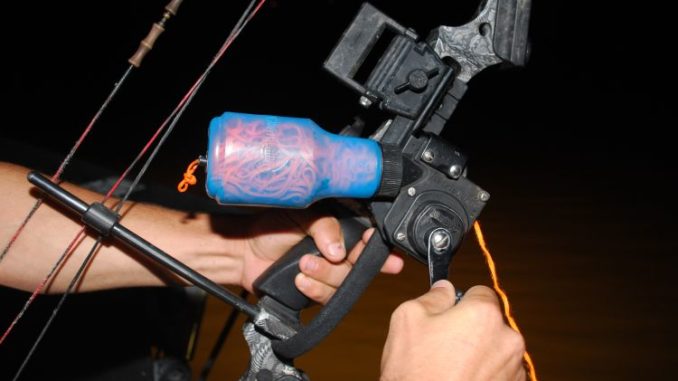
Early in the evening, Roy Lally IV explained the tools of the trade to me, starting with the most obvious: bows.
These are conventional compound bows set at 25 pounds draw.
“Some people shoot more draw, but it’s unnecessary,” Lally explained. “If you miss a fish, the arrow sticks too deep in the mud to be easy to pull out. If you hit an oyster shell or even gar scales, it can shatter the fiberglass arrow shaft.
“Plus, pulling all night on a bow with a lot of draw can be tiring.”
Bowfishing arrows are made of fiberglass and have no fletching to guide the flight of the shaft; shots are made up close and personal to the target.
Instead of fletching, a stopper is screwed to the shaft near the nock to keep the line from detaching.
Bowfishing arrow tips have large barbs that prevent fish from pulling free, but it also make arrows impossible to back out of the fish. Removal is accomplished by forcing the arrow tip through the body of the fish; the tip is slightly unscrewed, allowing the barbs to be reversed, and the arrow is pulled backwards.
The reel doesn’t even faintly resemble anything else called a fishing reel. Line is retrieved by depressing a trigger shaft with the hand holding the bow to tighten two rubber wheels that pinch the string.
Turning the reel handle with the other hand pulls in the line that is stored in a simple plastic bottle.
Arrowed fish are brought in by hand rather than being fought with the reel, but the reel is useful for retrieving line after missed shots (and there are lots of those).
The biggest tool of all, according to Capt. Graylin Schultheis and Lally, is the boat. Airboats are the standard for bowfishing, but they are incredibly noisy, making conversation challenging.
Schultheis’ specially designed boat has two 37-horsepower Gatortail surface drive engines mounted on its transom.
Shouting is never necessary on the boat.
Nighttime bowfishing is all about lights. Schultheis uses 12e 300-watt quartz lights mounted under a sturdy shooting platform set around the bow of the boat. He prefers quartz over LED lights mainly because they have more penetrating power, but also because they make redfish glow.
Redfish are their primary targets, but black drum and sheepshead are commonly taken. Alligator gar are there if customers want them.
During some times of year, flounders are not uncommon.
